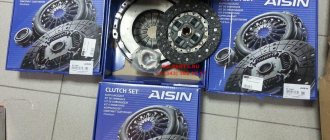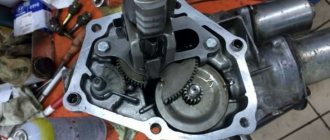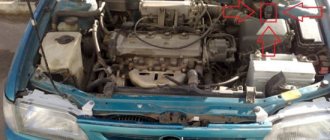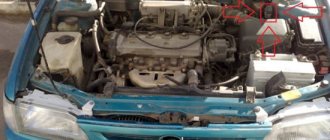Even though Japanese cars are famous for their technical reliability, even the legendary Toyota Corolla 150 requires replacement of the fuel filter, since its service life depends on the quality of the fuel supplied to the engine. The structure is installed in the gas tank and is a standard unit installed in passenger cars.
Corolla 150 may look epic)
The fuel filter is quite simple in design and includes the following elements:
- Coarse filter – protects the engine from excessive humidity and large foreign impurities in the fuel;
- Fine filter element – prevents elements invisible to the human eye from entering the engine;
- Gasoline pump;
- Fuel level sensor;
- Fuel line.
Any owner is able to independently replace the gas filter, or replace the entire fuel module at once.
Features of work
The fuel pump in the Toyota Corolla, which is found on most models with a 120, 140 and 150 body, works on this principle: at a given point in time, a fuel-air mixture is injected in certain proportions and volumes into the engine. This happens through the injector nozzles. The combustion of the mixture occurs after ignition by a spark from the candles.
Unlike carburetor engines, which were no longer installed on the Corolla since 1998, there is a saving in fuel consumption and an increase in traction power by 10%. It also ensures maximum reduction of harmful substances in exhaust gases entering the atmosphere.
An injection engine requires a more careful approach (such units are installed on Toyota Corolla models 120 and 150) both in maintenance and repair. Therefore, replacing the fuel pump and carrying out repair work, its removal and installation, if possible, should be carried out at a service center.
In addition to ensuring the supply of fuel to the engine, the pump regulates the required optimal pressure level in the fuel supply system.
Toyota Corolla fuel pump replacement
The main symptoms of a faulty fuel pump are expressed in a decrease in the power and dynamics of the car, failures in acceleration and unstable engine operation in idle mode. In addition, a clear sign of deterioration in the operation of the fuel pump is its howling or constant unpleasant hum, characteristic of excessive wear of the pump part due to the use of low-quality (poorly purified) fuel. Recently, cases of failure of fuel pumps in summer in hot weather have become more frequent. This is explained by the fact that if there is insufficient pressure in the system, the fuel boils, air pockets form in the turbine part of the fuel pump and, as a result, the fuel supply completely stops. Fuel pump malfunctions are divided into electrical and mechanical. Electrical systems rarely cause problems. Over time, the brushes or armature commutator of an electric motor may wear out, but this happens after a mileage of over 150–200 thousand km. By this time, as a rule, the discharge part of the pump fails. In our operating conditions, the biggest problem for fuel pumps in cars with electronic injection systems is dirty fuel. The smallest mechanical impurities contained in such fuel contribute to wear of the rubbing surfaces of the pump part and sharply reduce the service life of the pump as a whole. The reason for the reduction in the service life of this unit may also be systematic driving with a low fuel level in the tank when the reserve fuel indicator is on.
NOTE
Fuel pumps are cooled by gasoline passing through them, and with its help the parts of the pump part are lubricated. Do not allow fuel remaining in the tank to be less than 5 liters.
Pre-check the pressure in the fuel supply system in the following order.
1. Check the serviceability of the fuel pressure regulator (see “Checking and replacing the fuel pressure regulator”).
2. Remove the pump and wash the fuel inlet strainer. If in this case the pressure does not increase, the fuel pump must be replaced.
You will need: a flat-blade screwdriver, a container for draining gasoline from the fuel pump module.
1. Reduce the pressure in the power system (see “Reducing pressure in the power system”).
2. Disconnect the wire from the negative terminal of the battery.
3. Remove the rear seat cushion (see “Removing and installing the rear seat”).
4. Use a screwdriver to pry off the hatch cover.
5. Press the latch and disconnect the wiring harness block from the fuel pump module.
6. Disconnect the adsorber outlet pipe.
7. Use a screwdriver to pry the clamp and disconnect the tip of the additional fuel vapor outlet from the fuel tank.
8. Press the ears of the clamp...
9. ...and disconnect the fuel vapor exhaust pipe.
10. Using a screwdriver...
11. ...remove the clamp...
12. ...and disconnect the pressure pipe.
13. Unscrew the pressure ring of the fuel pump module counterclockwise...
14. ...and remove it.
15. Remove the fuel pump module and drain the fuel from it into a previously prepared container.
16. Remove the sealing gasket.
17. Press out the two latches...
18. ...and remove the fuel pump mount.
19. Squeeze the plastic clamp as shown in the photo...
20. ...and disconnect the wiring harness connector from the fuel pump.
21. Slide the fuel pump out of the housing.
22. Using a screwdriver, pry up the five latches...
23. ...and remove the strainer mounting bracket.
NOTE
Wash or replace the strainer if it is very dirty.
24. Remove the pump from the module housing.
25. Reassemble the fuel pump module in the reverse order of disassembly.
26. Install the parts in the reverse order of removal.
NOTE
When installing the fuel module, make sure that the two protrusions on its top...
...coincided with two slots on the fuel tank flange.
Source: https://toyotauto.net/corolla/zamena-toplivnogo-nasosa.html
Causes of malfunction
You can suspect a malfunction of the fuel pump of a Corolla 120 or 150 body based on the following characteristic signs:
- A decrease in engine power, which occurs due to wear of the fuel pump and requires its replacement.
- The engine does not start well even after proper warming up. This occurs due to the wear and tear of the valve that maintains the pressure in the system at the required level, or the gas tank mesh may be dirty, which can be removed and cleaned or simply replaced.
- Jerky movement can also be caused by both wear of the pump elements and third-party contamination.
- The engine often stalls and stalls.
- Extraneous noises during engine operation.
The presence of these malfunctions is a reason to seek help from a service station to receive qualified assistance, which usually begins with diagnostics (high-quality diagnostics are carried out using Bosch equipment). Most often, when the components wear out, the fuel pump is replaced, as well as consumables that ensure its uninterrupted operation.
Other causes of fuel pump malfunction include:
- Low quality fuel, as well as the presence of impurities, dust and water in it.
- Accumulation of condensate in the gas tank due to temperature changes.
- The habit of driving with a tank less than half full of gasoline.
- Dirty fuel filters.
You can choose the right fuel pump if you know exactly the make and model of the engine.
How to determine a faulty fuel pump
In order to determine a malfunction in the fuel pump, a special device is required that measures the pressure that is created in the fuel line. Measurements are carried out in three options:
- without turning on the engine;
- idling;
- 5 minutes after stopping the engine.
If the pressure in the fuel line within 5 minutes after stopping the engine becomes less than 1.5 kgf/cm2, and while the engine is running at idle speed the instrument reading is less than 3.1 kgf/cm2 or exceeds 3.5 kgf/cm2, then replace fuel pump in Toyota Corolla is the only right solution.
Rules for removal and replacement
It is necessary to remove the fuel pump in models with a body size 120 and above after first removing the rear seat. It is under it that there is a hatch for the gas tank, under which you can find the fuel module along with the fuel line. There is also a power supply connector for the fuel system.
Dismantling the fuel module must be done very carefully to prevent damage to the plastic housing and fasteners. The module is removed after being completely disconnected from the fuel line and disconnected from the electrical connector.
Quite often, the cause of incorrect operation of the fuel pump can be a clogged mesh of both the coarse filter and the fine filter. This involves replacing the pump and all filters included with it.
Before installing the fuel pump for Toyota Corolla 12 and above, it should be checked on a diagnostic stand along with the entire complex involved in supplying fuel to the engine.
After the verification procedure, the module is installed and connected to the mains. It is necessary to monitor the quality of installation of sealing elements - sealing rings and gaskets, which are responsible for the penetration of excess air into the system. After this, the rear seat is installed in place. Timely diagnostics, high-quality maintenance and proper operation are the key to efficient operation of not only the fuel pump, but also all vehicle systems as a whole.
Symptoms of a problem
The fuel pump in most Toyota cars equipped with gasoline engines is installed in the fuel tank. A clear sign of its malfunction is the lack of gasoline in the combustion chamber, as a result of which the car does not start.
Occasionally, the pump may shut down or reduce its performance. As a result, the pressure in the fuel rail becomes lower than normal. In this case, it is difficult to accurately diagnose the fault. It is impossible to do without special measuring instruments.
Signs of a fuel pump malfunction are as follows:
- jerking may occur when moving;
- the engine idle speed begins to “float”;
- the power unit starts poorly at any ambient temperature.
Generator Toyota Camry
The new generator for Toyota Camry provides uninterrupted power supply. A cheap and used Toyota Camry generator has very little durability, a short service life and a very high level of noise and radio interference. A new generator has enough power to charge the battery, but a cheap and used one may not have enough power, even to ensure normal consumption. If the car has non-standard music, an amplifier, or, for example, an autostart system, then you can take a generator with a high charging current. If there is an option for a refurbished generator, then you can safely take this option. Such generators are rebuilt at the factory and their service life is close to that of a new generator.
Most often, a generator for a Toyota Camry is purchased when it cannot be repaired, or the cost of repair exceeds the purchase of a new generator. Before purchasing a new generator for Toyota Camry, we recommend paying attention to those models whose repair will not cause problems in the future. Almost all models made in Germany and Italy have spare parts for repair, but for Chinese models it will be difficult to find spare parts.
Generator price:
| Options | Price | Buy |
| Generator Toyota Camry | from 4800 rub. | |
| Generator Toyota Camry refurbished | from 3700 rub. |
Buy a generator:
Phone: 8 (812) 409-46-75
Write to us on Whatsapp
The price of the generator depends on whether it is new, refurbished or used, the condition of the used one (degree of wear, mileage, etc.), the manufacturer, as well as availability in our warehouse or delivery time to our store.
Generator Manufacturers:
1. Original generator 2. Hella (Germany) 3. Bosch (Germany) 4. Denso (Japan) 5. ERA (Italy)
For engine
- 2.0 AT (148 hp)
- 2.5 AT (181 hp)
- 3.5 AT (249 hp)
- 3.5 AT (277 hp)
- 2.5 AT Overdrive (179 hp)
- 2.5 MT Overdrive (179 hp)
- 3.5 Dual VVT-i AT (277 hp)
- 2.4 VVT-i AT (169 hp)
- 2.4 VVT-i MT (169 hp)
- 2.4 MT (Japan) (157 hp)
- 2.4 VVT-i AT (152 hp)
- 2.4 VVT-i MT (152 hp)
- 2.4 AT 4WD (Japan) (157 hp)
- 2.4 AT (Japan) (157 hp)
- 3.0 AT (Japan) (210 hp)
- 3.0 AT (Japan) (192 hp)
- 3.3 AT Overdrive (US) (225 hp)
- 3.0 V6 AT (186 hp)
- 2.2 AT Overdrive (125 hp)
- 3.0 AT Overdrive (188 hp)
- 2.4 AT Overdrive 4WD (158 hp)
- 2.4 VVT-i AT (167 hp)
- 2.4 VVT-i MT (167 hp)
- 2.4 Hybrid CVT (147 hp)
- 2.4 AT 4WD (167 hp)
- 2.2 MT Overdrive (125 hp)
- 3.0 AT Overdrive (185 hp)
- 2.2 AT Overdrive (130 hp)
- 2.2 MT Overdrive (130 hp)
- 1.8 AT (105 hp)
- 1.8 MT (105 hp)
- 2.0 AT (140 hp)
- 2.0 MT (140 hp)
- 2.0 MT Overdrive 4WD (115 hp)
- 2.0 AT Overdrive (115 hp)
- 2.0 MT (120 hp)
- 2.0 AT Overdrive 4WD (115 hp)
- 2.5 AT Overdrive (153 hp)
- 2.5 MT Overdrive (153 hp)
- 2.0 TD MT (82 hp)
- 2.0 MT 4WD (120 hp)
- 2.0 TD AT (82 hp)
- 1.8 AT (85 hp)
- 1.8 MT (85 hp)
- 2.0 AT (120 hp)
- 2.0 AT 4WD (120 hp)
- 2.0 MT Overdrive (115 hp)
- 2.5 AT Overdrive (156 hp)
- 2.5 MT Overdrive (156 hp)
- 2.0 AT (95 hp)
- 2.0 AT (92 hp)
- 2.0 AT (150 hp)
- 1.8 TD AT (73 hp)
- 2.0 MT (95 hp)
- 2.0 DT AT (79 hp)
- 2.0 MT (92 hp)
- 2.4 MT Overdrive (154 hp)
- 3.0 AT Overdrive (190 hp)
- 3.3 AT Overdrive (210 hp)
- 2.2 AT Overdrive (136 hp)
- 2.2 MT Overdrive (136 hp)
- 3.0 AT Overdrive (194 hp)
- 3.0 MT Overdrive (194 hp)
- 2.2 AT Overdrive (133 hp)
- 2.2 MT Overdrive (133 hp)
- 1.8 AT (125 hp)
- 1.8 MT (125 hp)
- 2.0 AT 4WD (135 hp)
- 2.0 MT 4WD (135 hp)
- 2.2 AT 4WD (88 hp)
- 2.2 TD AT (91 hp)
- 2.2 TD MT (91 hp)
- 2.2 TD AT 4WD (88 hp)
- 1.8 AT (115 hp)
- 1.8 MT (115 hp)
- 2.0 AT (165 hp)
- 2.0 TD AT (91 hp)
- 2.0 V6 AT (140 hp)
- 2.0 MT (165 hp)
- 2.0 TD MT (91 hp)
- 2.0 V6 MT (140 hp)
- 2.5 AT (175 hp)
- 2.0 AT 4WS (140 hp)
- 2.0 MT 4WS (140 hp)
- 2.0 MT (121 hp)
- 1.8 TD MT (73 hp)
- 1.8 MT (100 hp)
- 2.5 AT (178 hp)
- 2.5 Hybrid CVT (178 hp)
- 3.5 AT (268 hp)
Modifications
- Toyota Camry V30 restyling
- Toyota Camry XV70
- Toyota Camry V10
- Toyota Camry V30
- Toyota Camry XV10 restyling
- Toyota Camry V40
- Toyota Camry V40 restyling
- Toyota Camry XV20 restyling
- Toyota Camry XV30 restyling
- Toyota Camry V10 restyling
- Toyota Camry XV10
- Toyota Camry XV40 restyling
- Toyota Camry XV50 restyling
- Toyota Camry V20
- Toyota Camry XV20
- Toyota Camry XV30
- Toyota Camry XV40
- Toyota Camry XV50
Replacement procedure
If the fuel filter has not been replaced and the mileage exceeds more than 100 thousand km, then you may not know how to replace the fuel pump on a Toyota Corolla. In this case, all elements (pump and filter) are combined into one unit. To replace, you need to purchase a fuel pump. If necessary, use a fuel filter. The operating procedure is as follows.
- Disconnect the negative terminal of the battery.
- Remove the lower part of the rear seat.
- Open the cover that prevents access to the gas tank.
Before disconnecting the fuel lines and removing the cap, prevent dust from getting inside the gas tank. The cap unscrews in a counterclockwise direction. - Remove the assembly.
- Unclip the bottom by removing the plastic clips holding the bottom in place.
- Remove the fuel pump along with the L-shaped filter.
Depending on the generation of the car, the components in which the fuel pump is installed may differ. So, in the Corolla 150 the unit consists of two components, and in the 120 version it is combined into one. When dismantling, focus on the coarse fuel filter, which has an L-shape.
The fuel pump holds nothing inside the plastic container except a rubber gasket. Don’t forget to install it in its place with the new part.
One of the reasons why a Toyota Corolla fuel pump may need to be replaced is a clogged filter element. Avoid operating the car with a minimum level of gasoline in the tank, since the fuel pump is cooled through fuel circulation.











